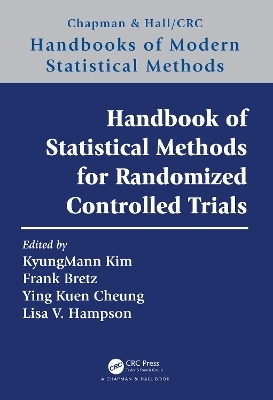
Handbook of Statistical Methods for Randomized Controlled Trials
Chapman & Hall/CRC (Verlag)
978-1-032-00910-0 (ISBN)
Statistical concepts provide scientific framework in experimental studies, including randomized controlled trials. In order to design, monitor, analyze and draw conclusions scientifically from such clinical trials, clinical investigators and statisticians should have a firm grasp of the requisite statistical concepts. The Handbook of Statistical Methods for Randomized Controlled Trials presents these statistical concepts in a logical sequence from beginning to end and can be used as a textbook in a course or as a reference on statistical methods for randomized controlled trials.
Part I provides a brief historical background on modern randomized controlled trials and introduces statistical concepts central to planning, monitoring and analysis of randomized controlled trials. Part II describes statistical methods for analysis of different types of outcomes and the associated statistical distributions used in testing the statistical hypotheses regarding the clinical questions. Part III describes some of the most used experimental designs for randomized controlled trials including the sample size estimation necessary in planning. Part IV describe statistical methods used in interim analysis for monitoring of efficacy and safety data. Part V describe important issues in statistical analyses such as multiple testing, subgroup analysis, competing risks and joint models for longitudinal markers and clinical outcomes. Part VI addresses selected miscellaneous topics in design and analysis including multiple assignment randomization trials, analysis of safety outcomes, non-inferiority trials, incorporating historical data, and validation of surrogate outcomes.
KyungMann Kim is Professor of Biostatistics and Statistics and Director of Clinical Trials Program, Department of Biostatistics and Medical Informatics, University of Wisconsin-Madison. He is a former associate editor of Biometrics and an elected Fellow of the American Statistical Association, the Society for Clinical Trials, and the American Association for Advancement of Science. Frank Bretz is a Distinguished Quantitative Research Scientist at Novartis. He is also an Adjunct Professor at the Hannover Medical School (Germany) and the Medical University Vienna (Austria). He is a former editor-in-chief of Statistics in Biopharmaceutical Research. a Fellow of the American Statistical Association, and a recipient of the Susanne-Dahms-Medal from the German Region of the International Biometric Society. Ying Kuen (Ken) Cheung is Professor of Biostatistics and Associate Dean for Faculty in the Mailman School of Public Health at Columbia University. He is a recipient of the IBM Faculty Award on Big Data and Analytics. He is a Fellow of the American Statistical Association and a Fellow of the New York Academy of Medicine. Lisa Hampson is a Director in Statistical Methodology at Novartis.
Part I. Introduction to Randomized, Controlled Trials. 1. Introduction. Part II. Analytic Methods for Randomized, Controlled Trials. 2. Dichotomous and ordinal: chi-square and Fisher's exact tests and binary regression models. 3. Continuous: t-test, Wilcoxon-test, and linear or non-linear regression models. 4. Time to event subject to censoring: logrank test, Kaplan-Meier estimation and Cox proportional hazards regression models. 5. Count: Poisson and negative binomial regression models. 6. Longitudinal: Linear and generalized linear mixed models, GEE. 7. Recurrent events. 8. Cross-over design. 9. Factorial design. 10. Cluster randomized design. 11. Randomization, stratification, and outcome-adaptive allocation. 12. Sample size estimation and power analysis: Dichotomous, ordinal, continuous and count. 13. Sample size estimation and power analysis: Time-to-event data subject to censoring. 14. Sample size estimation and power analysis: Longitudinal data. 15. Group sequential methods, triangular methods and stochastic curtailments. 16. Sample size re-estimation. 17. Adaptive designs. 18. Multiple testing. 19. Subgroup analysis. 20. Competing risks. 21. Joint models for longitudinal markers and clinical outcomes. 22. Sequential multiple assignment randomization trial (SMART) for dynamic treatment allocation. 23. Safety data analysis. 24. Non-inferiority trials. 25. Incorporating historical data into RCTs. 26. Validation of surrogate outcomes.
| Erscheinungsdatum | 28.09.2023 |
|---|---|
| Reihe/Serie | Chapman & Hall/CRC Handbooks of Modern Statistical Methods |
| Zusatzinfo | 101 Tables, black and white; 64 Line drawings, black and white; 64 Illustrations, black and white |
| Sprache | englisch |
| Maße | 178 x 254 mm |
| Gewicht | 1206 g |
| Themenwelt | Mathematik / Informatik ► Mathematik ► Statistik |
| Studium ► Querschnittsbereiche ► Epidemiologie / Med. Biometrie | |
| ISBN-10 | 1-032-00910-1 / 1032009101 |
| ISBN-13 | 978-1-032-00910-0 / 9781032009100 |
| Zustand | Neuware |
| Informationen gemäß Produktsicherheitsverordnung (GPSR) | |
| Haben Sie eine Frage zum Produkt? |
aus dem Bereich


